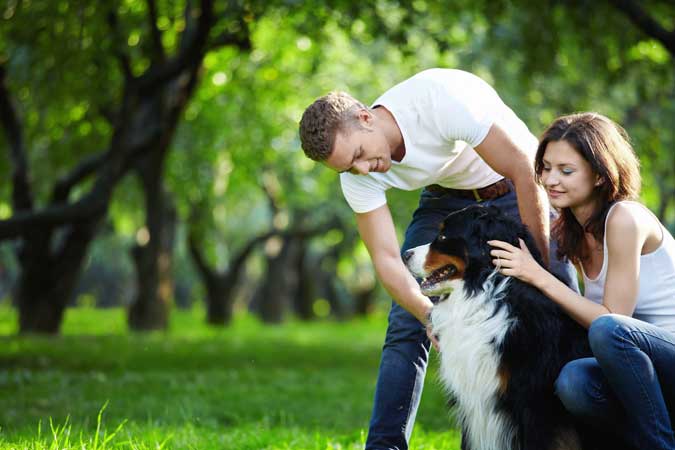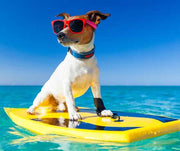Dog Park Etiquette

If you're a dog owner, you know that taking your dog out for some play and exercise is necessary for their health and well-being. However, your backyard or walking the same path everyday can get monotonous, or maybe you don't even have a spacious yard for your dog to run around in. This is where dog parks enter the picture!
WHAT ARE DOG PARKS?
Dog parks are specific places designated for your furry friend to run around in, let out some energy, and socialize with other dogs. They also help owners socialize too! Dog parks usually include areas that are fenced in where you are allowed to let your dog run and play off of his or her leash. We're going to go over a few etiquette tips and best practices when it comes to dog parks, so keep these in mind if you're planning your visit!
DOG PARK ETIQUETTE BEST PRACTICES
1. Follow the parks rules: Before entering the dog park, review its rules. Different dog parks may have different rules posted. Some parks may allow dogs to be off of their leash, but others may require dogs to be leashed at all times. Most dog parks also require that all dogs be up-to-date on their vaccinations before entering so that they don't acquire or spread any diseases to other pups.
2. You are responsible for your dog's behavior: Before you take your dog to the park for the first time, you'll want to ensure that he or she is properly socialized. You don't want your dog's first interactions with strangers and other dogs to be at a park where others are trying to enjoy their time. Unpredictable behavior can not only be annoying for you and others, but it can also be dangerous if your dog starts acting aggressively.
3. Pay attention to your dog's body language: It's important to note that you should be able to recognize the difference between playfulness and aggression with your dog. Not sure how to tell? A playful dog will be more relaxed, and its tail will likely be wagging. While growling may seem like a sign of aggression, it's normal for dogs to growl while they play. However, be on the lookout for yipping and snarling as well as a tense body position and stare-offs with other dogs, as these are signs of aggression. Improper behavior with your dog should be dealt with immediately and appropriately to avoid any harm or further conflict with other dogs.
4. Pay attention to your dog, 100% of the time: It's also important to remember that you are at a park for dogs. While it's fun to socialize with other pet owners and enjoy your time, ultimately you need to be watching your dog at all times to be sure he or she is behaving appropriately and not causing trouble. So don't get too distracted by talking with others or letting yourself be glued to your smartphone.

Be sure you also keep your leash with you at all times. Even if your dog is microchipped, you don't want him or her to make a run for it and escape from the dog park. Keep an eye on them if they are off their leash and keep the leash readily at hand. Also, be sure they are wearing their collar with tags for easy identification in case they do happen to get lost.
5. Pick up after your dog: It's always a good idea to bring plenty of waste bags with you to pick up your dog's poop. Some dog parks provide these, but be sure you bring some of your own just in case. Picking up your dog's waste is not only polite and will keep the ground clean, but it will also prevent the spread of possible diseases and parasites that can be found in feces.
6. Never bring a female dog in heat: It's important to not bring a dog that has not been sprayed or neutered to a dog park, especially if it's a female dog in heat. This puts them at the risk of possibly getting pregnant. Plus, it can cause conflict and aggression among your pup and the other dogs there.
7. Don't bring puppies under 12 weeks: As mentioned earlier, many dog parks require that dogs be up-to-date on all of their vaccinations. Puppies that haven't received all of their vaccines are at risk of picking up certain diseases, parasites, worms, or other possible serious illnesses.
8. Don't bring food into the park: You may be tempted to bring a treat for your dog into the park. But handing out treats could end up causing a conflict and fights among the other dogs there. Plus, you never know if any of the dogs have allergies to specific foods. That's why it's a good idea to leave dog treats (and human treats) outside of the park to enjoy later.
CONCLUSION
If you're looking for a great place for your dog to get some social time with other dogs as well as have a chance to play and exercise, dog parks are a great place to take them! Check your area to find a park that's close to you, and keep these etiquette tips in mind so that you, your dog, and all the other parkgoers can enjoy your time to the fullest!
Sources:
Previous article

Next article

Related posts
View all-

Setting Up the Perfect Cat Space: Essential Furniture and Accessories
Creating a dedicated space for your cat can make life better for both you and your furry friend. For cat parents, having the right furniture and accessories ensures your pet feels comfortable, entertained, and safe. A well-thought-out setup also blends seamlessly with your home, keeping both human furniture and cat-approved pieces in harmony.
Read Article -

New Dog Checklist: Everything You Need for Bringing Home a New Dog
Bringing a new dog home is exciting, but it can also feel a bit overwhelming if you’re not fully prepared. Without the right supplies, the first few days can be stressful for both you and your new furry friend. Imagine bringing your adopted dog home only to realize you forgot something as simple as a dog brush or training treats. It can leave you scrambling and unsure of where to start.
Read Article -

New Kitten Checklist: Getting Your Home Ready For Your New Cat
Whether you're a first-time kitten parent or a kitten parent pro, bringing home a new kitten is always an exciting time. Watching your kitten get used to their new surroundings is one of the cutest things you could witness. However, if you're not prepared, your kitten may have a harder time adjusting. To get prepared, keep reading for our New Kitten Checklist.
Read Article



